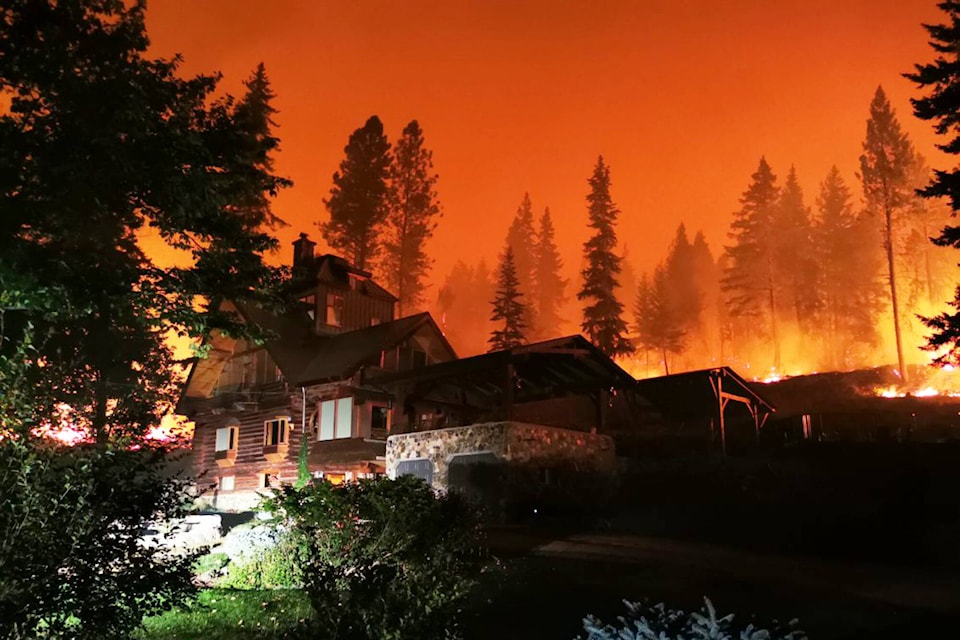Part 1 of a 2-part series.
We attended our first environmental conference in 1989, at which David Suzuki was reduced to tears when he described what could happen if humanity did not address climate change by reducing carbon emissions as soon as possible.
Although my focus in succeeding years was advocating for wilderness protection and improving forest management, the climate issue was always in the background.
In 2003, we witnessed flames in the hills behind Chase on a Friday night while returning home from a Roots and Blues festival, where ashes were falling from a nearby fire above Silver Creek, and we called it in.
By the following evening, the Neskonlith fire had grown huge, and we were on evacuation alert. Firestorm 2003 was a wake-up call, and in succeeding years I worked hard to advocate for climate change mitigation.
After realizing how emissions were only increasing, my focus shifted to adaptation, as then and even more so now, our biggest concern is survival.
Despite the increasing amount of forest area burned as temperatures increase and intense weather events become the norm, governments continued to delay efforts to FireSmart communities, while they carried on subsidizing oil and gas industries.
This year, when the UN chief changed the term to climate boiling, the writing was on the wall given the severe drought.
Knowing it was not a question of if, but when a fire could hit us, we began work a few years ago to fireproof our property, by removing small trees, trimming branches and removing the junipers next to our home. Last fall, we chose to selectively log our property and made sure to remove most of the trees near our home. This spring, we replaced the wood siding on one outside wall of our log home with metal. Yet, there was not time to do much clean-up, and much of the logging debris was left and we had plans to pile and burn it this fall.
After lightning started two fires on either side of Adams Lake on July 12, my initial concern was the same as in previous years: Why were these fires not put out initially? The reason is obvious, as Canada has not made the investment in the resources needed to adequately fight wildfires.
Federal politicians focus more on purchasing fighter jets and warships, than buying the water bombers and water skimmers needed to douse fires when they first start, while provinces have far too many other priorities.
Then my dread about what could soon come intensified on July 20 when the Adams Lake East fire exploded and became visible that evening in Squilax. Yet, adequate resources were not put on the fire until it nearly burnt homes on the lakeshore, but by then it was too late.
Once fires reach a certain size, only a change in weather will put them out. A few weeks before the big firestorm, the BC Wildfire Service (BCWS) set up a large camp at the Squilax airstrip, as if they knew what was coming.
There is a NASA website that is updated daily with a satellite map that shows fire hot spots across North America, and I watched it like a hawk. Seeing the fire move closer to us, our concerns grew stronger.
On Aug. 17, when the BCWS announced their plans to do a controlled burn in the hills above us, our fears intensified even more.
During the afternoon before the controlled burn, a BCWS crew arrived and installed a 25,000-gallon water tank on our road and ran hoses to sprinklers on the roofs of most of the homes near us. I had already been sprinkling the hillside behind our home and these sprinklers would be able to add to my efforts. Shortly after 5 p.m., we witnessed and took photos of a giant mushroom cloud of smoke rising in the hills and from the lake. I took a photo that showed the smoke drifting eastward. That night, the sky was red.
The following morning, the sprinklers were on and BCWS announced their controlled burn was a success, so we breathed a sigh of relief.
Then at noon, our daughter was driving through Scotch Creek, saw flames in the hills and phoned immediately to urge us to evacuate.
Fortunately, we had our essentials packed and ready, and thus we soon left.
It took the CSRD another hour and a half to issue the order for Lee Creek and Scotch Creek, and by then it was too late for those who ended up evacuating by boat or driving to Seymour Arm. They did not issue the order for Celista until after most of the homes had burnt.
It was a miracle no one died.
The 2023 Shuswap firestorm became a multi-headed colossal monster, as the fire on the west side moved south to Sorrento and Turtle Valley, while the fire on the east side went past Celista. Over 200 homes and businesses were reduced to ashes, and much of the forest is burnt to a crisp.
Our home place that we love and cherish has been forever changed, the magnificent trails we love to hike are black and grey, the wildlife habitat is gone and now we fear the inevitable landslides and floods that will come when heavy rain falls where the moisture cannot be absorbed because the trees are dead, and the soil is burnt.
newsroom@saobserver.net
Like us on and follow us on



